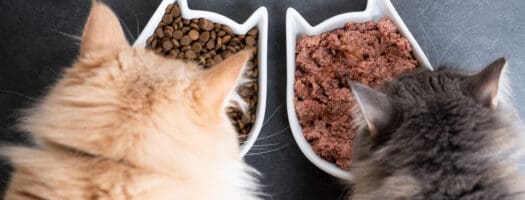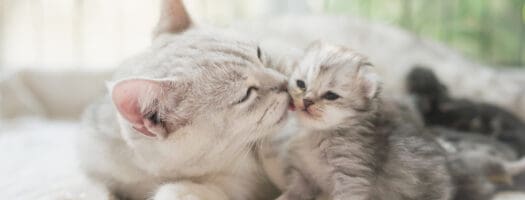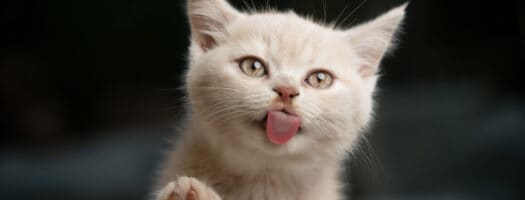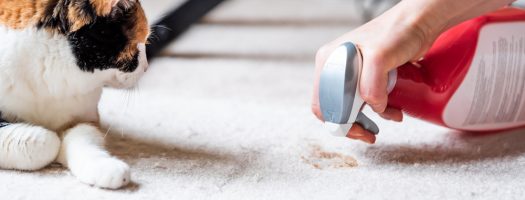How Long Can Cats Go Without Water?
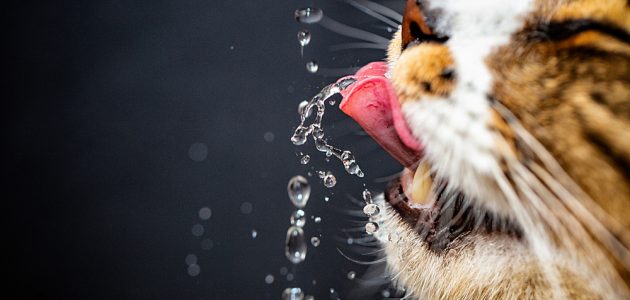
It’s every cat owner’s worst nightmare. Your cat goes missing for three days and you discover they’ve been locked in the backyard shed the whole time, with no access to food or water.
You’re not alone. Many other unfortunate cat owners have been there. And, since most of these curious felines ended up perfectly fine, it makes people wonder how long cats can go without water.
The short answer is about three days without any serious consequences, though this number can vary, so keep reading as we delve into everything you need to know about your cat’s water intake.
Studies on How Long Cats Can Go Without Water
There’s bad news for those who like definite answers with lots of scientific studies to back it up, because there are no studies on how long a cat can survive with no water.
This is good news for cats, however, as a study on this would have to involve dozens of cats being deprived of water while scientists sat there and wrote about how they declined and how soon they died.
What we do know is that most cats that have found themselves without access to water for three days or less typically make a full recovery without any obvious side effects. There are numerous stories of cats that went a few days without food or water and were perfectly fine afterwards, and expert opinions back up this anecdotal evidence.
That being said, dehydration can set in fairly quickly for cats, especially since they’re not naturally good at drinking water.
A few things, like a cat’s size, activity level, and the temperature have an effect on how much water a cat needs to drink. Ideally, they should drink at least 2-4 ounces each day, but they should manage up to three days without any harm and are typically able to survive for about about a week without any water at all thanks to their adapations to living in environments where droughts are common.
Why Cats Are Bad at Staying Hydrated
It may sound strange to say that cats aren’t able to drink enough water, but it’s true. Unlike dogs and many other animals, cats aren’t driven to seek out water sources and drink from them. There’s a reason for it, though.
Domestic cats aren’t that different physically from their wild ancestors. They were desert animals originally, and got most of their daily water intake from their prey. Mice, birds, and other small animals are usually eaten whole by cats which means a cat’s natural diet is moist.
However, your typical housecat eats dry cat food that contains less than 14% moisture. Compared to a small rodent that would have between 65 and 80% moisture in its body, it’s easy to see why so many cats on dry food diets suffer from dehydration.
When you combine that with a cat that’s also finicky about where he gets his water from, it gets even worse. Some cats refuse to drink from certain water sources which can quickly become dangerous for them.
Dangers of Dehydration in Cats
Let’s dig deeper into some of the things that can happen to your cat if they become dehydrated. As you’ll see, these are things that no cat owner wants to face for their fur baby!
Kidney Disease
The kidneys are primarily responsible for filtering waste out of the bloodstream. When your cat becomes dehydrated, there’s less blood flowing through his body and his kidneys have to work harder to do their job.
Over time, this leads to kidney disease and your cat’s kidneys can start to fail. One study found that over half of the cats had some form of chronic kidney disease, which shows that many cats may have it already without their owners being aware.
Chronic kidney disease can be treated but it’s not reversible which is one reason it’s crucial to make sure your cat is drinking enough water to avoid being at risk for developing this condition.
Heart Disease
This is another problem cats face if they’re not getting enough water. As with kidney disease, the heart needs a certain amount of blood to work well. When the blood becomes thick from lack of hydration, the heart has to work harder to get blood to every part of the body.
As you can imagine, heart disease is fatal to cats. Also like kidney disease, there’s no cure and once the heart has become damaged, the damage is irreversible. Although there are some treatment options to limit the effects of cardiomyopathy, it’s best to avoid it in the first place.
Drug Sensitivity
When a cat has less water in their body, medications can have a stronger effect because they end up being more highly concentrated.
Imagine if you added a drop of food coloring to a teaspoon of water and a gallon of water. While a single drop will completely change the color of the water in the teaspoon, you probably won’t even notice a change in the gallon.
That’s why it’s essential to make sure your cat stays hydrated. Even medications that are normally considered safe can end up doing some serious damage to your cat when your cat is dehydrated because the side effects are more likely and more severe.
Dehydration Symptoms to Watch For
If you’re worried about your cat being dehydrated right now, here are a few things you should be looking out for. In most cases, these will mean that your cat is in desperate need of hydration and you should take them to the veterinarian as soon as possible.
Here are the symptoms of dehydration in cats:
- Lethargy
- Lack of appetite
- Sunken eyes
- Depression
- Dry mouth
- Panting
- Fast heart rate
To test your cat for dehydration, pinch the skin of the back of his neck and pull it up gently so it forms a “tent.” Then, release it. It should return to normal within a second. If it doesn’t, your cat is dehydrated and should be seen by a veterinarian immediately.
Making Sure Your Cat Is Drinking Enough Water
Since many cats won’t drink enough water when left to their own devices, it’s important for you as their owner to make sure they’re getting enough so you don’t have to wonder about how long cats can go without drinking water.
Here are some ways you can encourage your cat to drink more water so you don’t have to worry so much about some of the risks of dehydration.
Keep Water in Sight and in Mind
You know the saying, “Out of sight, out of mind.” It works the same way for your cats. If they don’t see water, they don’t think about drinking it. For that reason, one of the first things you want to do is make sure you put their water somewhere they’re going to see it often.
Another part of this is having multiple water bowls throughout the house. That way, no matter where your cat is, he always has easy access to water.
If you’re in a multiple-cat household, this is even more important as cats can sometimes claim parts of the house and will prevent the other cats from getting to the water source. This is known as resource-guarding and it can be dangerous for the cats on the bottom of the pecking order.
The Freshest Water Is the Best Water
Who doesn’t love fresh water? In the wild, standing water was more likely to be filled with bacteria and other undesirable things so cats instinctively avoid drinking from stagnant water. It’s also why so many of them seem obsessed with drinking from running taps, like this one.
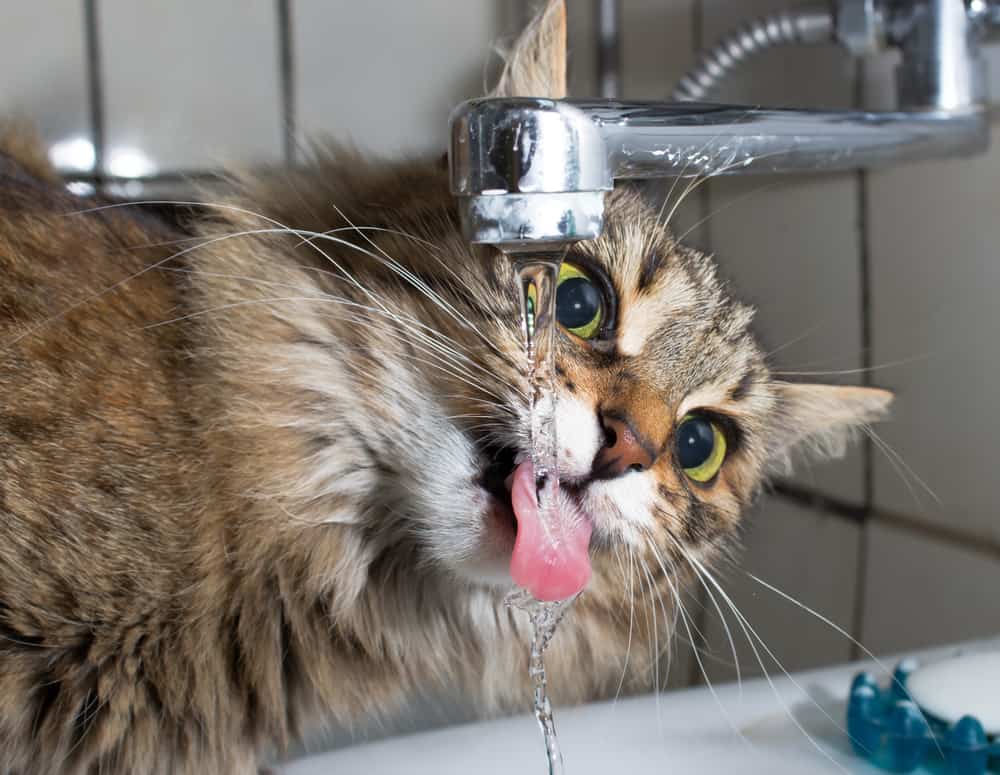
Make sure you provide your cats with fresh water by emptying out their water bowl and filling it with clean, fresh water instead of just “topping up” their bowl. If you can, give them filtered water as tap water can contain chemicals that may be harmful for cats.
While you’re at it, you’ll also want to make sure you wash out your cat’s bowl frequently. It can develop a coating of “slime” from bacteria that comes from your cat’s mouth. Would you drink out of a slimy cup? Probably not, and your cat certainly doesn’t want to do that, either!
For ultimate freshness, consider getting a cat fountain. There are a number of different options available but they all have one thing in common: they ensure that your cat always has fresh running water to drink from.
Wet Food, Not Dry Food
Possibly the easiest way to make sure your cat is getting plenty of moisture is to change them to a wet food diet. Most wet foods contain around 80% moisture, which is the same level your cat would be getting from hunting for their meals.
To take it to the extreme and get other health benefits, consider switching your cat to a raw diet, which should provide even more moisture than canned wet food. Take your time to do your research and find some good sources for raw meats for your cat and you may find that this is a great option for you and your cat.
Keep Food and Water Apart
Something you may be doing wrong when it comes to keeping your cat hydrated is putting his water too close to his litter box and food. Cats don’t like to drink near their waste. Who would? You certainly wouldn’t bring a glass of water with you to the bathroom.
But what about food? That, too, goes back to a cat’s wild instincts. Cats don’t like to eat near their water sources because the decaying body of the animal they killed can easily contaminate the water. Your typical housecat doesn’t have to worry about that, but still has that urge to go somewhere else to drink after eating.
So, even though it may look nice and be more convenient to keep your cat’s food and water bowls in the same place, it may be putting your cat at risk for dehydration.
What to Do if Your Cat Doesn’t Drink for Days
When cats do go without food or water for a few days, they may appear to be fine. However, your veterinarian is the only one that can help you determine how much medical assistance your cat may need to be as healthy as possible.
The first thing you should do if your cat has been trapped anywhere for more than 24 hours is give your veterinarian a call. They may simply suggest allowing your cat to eat and drink freely if they’re otherwise healthy or they may want to run some tests to check kidney and heart function.
Final Thoughts
If the vet isn’t worried about serious harm, there are still some things you can do to help your little kitty feel better. Make sure you have plenty of fresh water throughout the house. If your cat looks sick or is panting, you can even mix a few drops of Pedialyte into their water or feed it to them through a bottle. If they’re refusing to drink, try to get them to lick ice chips.
Chances are that even after a few days without water they’ll be perfectly fine, so don’t panic and try to help them recover as much as you can.
